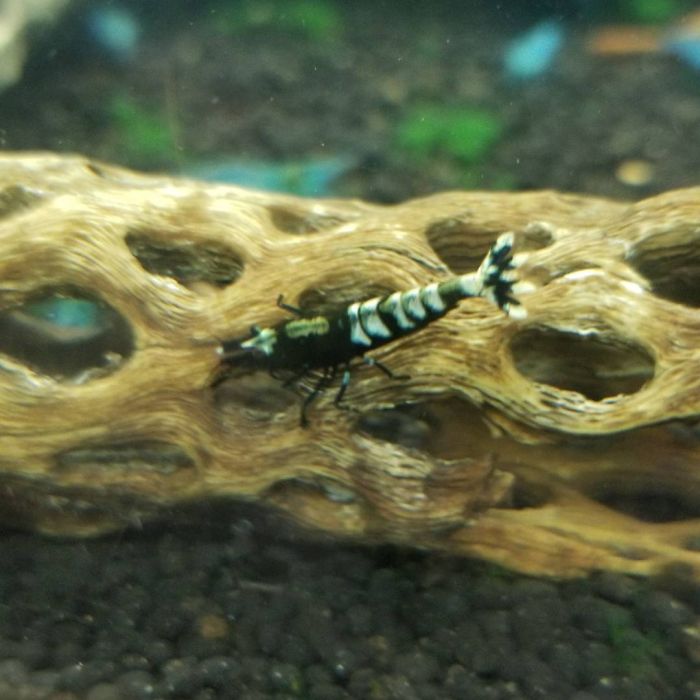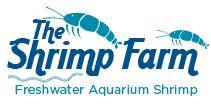Fishbone shrimp (fishbone pinto) | Care & info
Been keeping shrimp for a while and feel like you're ready for the next challenge? Fishbone pinto shrimp are a relatively new addition to the hobby, and a spectacular one at that! Though not the easiest to keep and breed, they make up for it with their spectacular coloration and pattern.
Keep reading for everything you need to know about fishbone pinto shrimp and keeping these beauties in your aquarium!
| Scientific name | Caridina cantonensis x mariae |
| Common names | Fishbone shrimp, fishbone pinto shrimp, pinto shrimp |
| Difficulty level | Intermediate |
| Origin | South-East Asia |
Table of Contents
Fishbone shrimp requirements
Fishbone shrimp aren't the best beginner choice. If you're looking to get into shrimp keeping for the first time, why not look into getting an easier species like red cherry shrimp? They are less expensive and a lot hardier.
If you have some shrimp experience and are ready for the next step, be sure to go for at least a 10-gallon aquarium. After all, the larger the tank, the smaller the chance of any issues caused by bad water quality.
Make sure the filter you use is 100% shrimp safe to prevent any fry from being sucked in. A sponge filter should work well. You can use a heater to keep the aquarium temperature stable, although some shrimp keepers prefer heating their entire room to a suitable temp.
Like all shrimp, fishbone pintos like having some decorations and hides in their tank that they can retreat to while molting and eat biofilm off. Try adding some kind of moss and a few shrimp tubes to keep your fishbone shrimp happy.
Water quality
The key element to keeping your fishbone pinto shrimp colony healthy is water quality (as well as stability). These shrimp are heavily selectively bred and can be quite vulnerable to bad water values, so stay on top of your water tests at all times (use a liquid test kit instead of strips).
Most importantly, your tank should always be fully cycled without any traces of ammonia and nitrite. Nitrates should be kept low as well by doing regular water changes. Add the new water very slowly, using the drip method for example, to avoid sudden swings in water values.
Because fishbone pinto shrimp can be pretty particular about water values, many aquarists prefer to use RO (reverse osmosis water) and a pH-lowering substrate. This basically allows them to create their own water values and be 100% sure there are no unwanted substances in there.
pH: 5.8-7.4
Temperature: 62-76 °F
GH: 4-6
KH: 0-4
Total Dissolved Solids: 100-200
Tankmates
Most fishbone pinto shrimp keepers and breeders can probably agree that a single-species setup is the way to go for these shrimp. At their price point and fragility, you can't afford to lose any fry and certainly no adults. A few snails should be fine if you're sure they're disease-free and shrimp safe.
Fishbone shrimp diet
As with all dwarf shrimp, a fishbone pinto's favorite food is biofilm. This organic substance grows on any surface in the aquarium, which means your fishbones will appreciate it if you don't clean your tank too intensely. A few patches of algae are like a shrimp feast!
Supplement their diet using a high quality shrimp food and additions like leaf litter. Be sure to remove any uneaten foods within a few hours; you don't want anything rotting and spoiling the water.
Breeding fishbone shrimp
If you're interested in keeping fishbone pinto shrimp, you can choose to produce them yourself through selective breeding. This option does take quite a bit of time, so if you want to enjoy your fishbones now you're probably better off buying a starter colony.
So how are fishbone pintos produced? Hope you're ready, here it comes:
- Crystal red/black shrimp or Taiwan Bee shrimp (Caridina cantonensis) are crossed with tiger shrimp like the orange-eyed blue tiger (Caridina mariae). This produces Tibees.
- To produce your fishbone shrimp, you cross these Tibees back to a Taiwan Bee shrimp to produce TaiTibees.
- Then, breed selectively to get to the desired color pattern that makes the shrimp a Pinto.
When breeding fishbone pinto shrimp, keep in mind that their breeding rate can be slower than that of 'regular' non-hybridized shrimp. Taiwan Bee shrimp can be fragile and breeding two of them together might result in loss of all fry, which means you should always be careful about which shrimp you decide to breed.
Buying fishbone shrimp
Fishbone pinto shrimp are relatively new in the shrimp hobby and they are still on the rare and expensive side. You probably won't find these in your local fish store, but luckily there are some online sellers you can buy from.
The Shrimp Farm sells black fishbone shrimp with live arrival guarantee; you can easily order your fishbones here.



 Shrimp
Shrimp Fish
Fish Crab &
Crab & Plants
Plants Foods
Foods Snails
Snails
